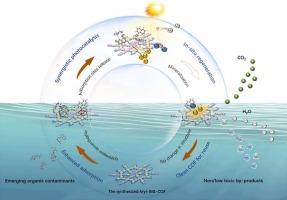用芳基二胍武装的共价有机框架原位自清洁去除新出现的有机污染物
IF 12.2
1区 环境科学与生态学
Q1 ENGINEERING, ENVIRONMENTAL
引用次数: 0
摘要
首次开发了一种具有芳基双胍臂的原位自清洁共价有机骨架(Aryl-BIG-COF),用于去除水中新出现的有机污染物,如心得安(PRO)。主要突破是功能性活性位点的稀缺性、非原位再生的不可行性以及电子空穴对在COFs应用中的快速重组。由于芳基双胍臂的定向捕获能力和电子结构调控,新合成的COF的吸附量和光催化降解率分别提高了近4倍和7倍。在活性位点光催化再生的驱动下,其自清洁能力使PRO能够在原位去除,并在6个循环后保持90%以上的去除效率。此外,它被证明广泛适用于去除PRO和其他新出现的污染物,如双酚A (BPA)、四环素(TC)和诺氟沙星(NOR),跨越各种水基质,残留毒性较小。天然水体中有机物和离子的共存促进了PRO的去除。其增强机制是芳基双胍臂缩小带隙,诱导局部电荷极化,从而提高电子空穴对的分离效率。这项工作为COFs净水的结构设计和实际应用提供了重要的见解。本文章由计算机程序翻译,如有差异,请以英文原文为准。

In situ self-cleaning removal of emerging organic contaminants with covalent organic framework armed with arylbiguanide
An in situ self-cleaning covalent organic framework featuring arylbiguanide arms (Aryl-BIG-COF) was first developed to remove emerging organic pollutants such as propranolol (PRO) from water. The main breakthroughs addressed the scarcity of functional active sites, the impracticality of ex situ regeneration, and the rapid recombination of electron hole pairs in the application of COFs. Owing to the directional capture ability and electronic structure regulation of the arylbiguanide arms, the adsorption capacity and photocatalytic degradation rate of the newly synthesized COF increased by nearly four and seven times, respectively. Its self-cleaning ability, driven by the photocatalytic regeneration of active sites, enabled in situ removal of PRO and sustained over 90% removal efficiency after six cycles. Moreover, it demonstrated broad applicability for removing PRO and other emerging pollutants, such as bisphenol A (BPA), tetracycline (TC), and norfloxacin (NOR), across various water matrices with less residual toxicity. The coexisting organic matter and ions in natural water promoted the removal of PRO. The enhancement mechanism involved arylbiguanide arms narrowing the band gap and inducing local charge polarization, thereby increasing the separation efficiency of electron
hole pairs in the application of COFs. Owing to the directional capture ability and electronic structure regulation of the arylbiguanide arms, the adsorption capacity and photocatalytic degradation rate of the newly synthesized COF increased by nearly four and seven times, respectively. Its self-cleaning ability, driven by the photocatalytic regeneration of active sites, enabled in situ removal of PRO and sustained over 90% removal efficiency after six cycles. Moreover, it demonstrated broad applicability for removing PRO and other emerging pollutants, such as bisphenol A (BPA), tetracycline (TC), and norfloxacin (NOR), across various water matrices with less residual toxicity. The coexisting organic matter and ions in natural water promoted the removal of PRO. The enhancement mechanism involved arylbiguanide arms narrowing the band gap and inducing local charge polarization, thereby increasing the separation efficiency of electron hole pairs. This work provides significant insights into the structural design and practical applications of COFs for purifying water.
hole pairs. This work provides significant insights into the structural design and practical applications of COFs for purifying water.
 hole pairs in the application of COFs. Owing to the directional capture ability and electronic structure regulation of the arylbiguanide arms, the adsorption capacity and photocatalytic degradation rate of the newly synthesized COF increased by nearly four and seven times, respectively. Its self-cleaning ability, driven by the photocatalytic regeneration of active sites, enabled in situ removal of PRO and sustained over 90% removal efficiency after six cycles. Moreover, it demonstrated broad applicability for removing PRO and other emerging pollutants, such as bisphenol A (BPA), tetracycline (TC), and norfloxacin (NOR), across various water matrices with less residual toxicity. The coexisting organic matter and ions in natural water promoted the removal of PRO. The enhancement mechanism involved arylbiguanide arms narrowing the band gap and inducing local charge polarization, thereby increasing the separation efficiency of electron
hole pairs in the application of COFs. Owing to the directional capture ability and electronic structure regulation of the arylbiguanide arms, the adsorption capacity and photocatalytic degradation rate of the newly synthesized COF increased by nearly four and seven times, respectively. Its self-cleaning ability, driven by the photocatalytic regeneration of active sites, enabled in situ removal of PRO and sustained over 90% removal efficiency after six cycles. Moreover, it demonstrated broad applicability for removing PRO and other emerging pollutants, such as bisphenol A (BPA), tetracycline (TC), and norfloxacin (NOR), across various water matrices with less residual toxicity. The coexisting organic matter and ions in natural water promoted the removal of PRO. The enhancement mechanism involved arylbiguanide arms narrowing the band gap and inducing local charge polarization, thereby increasing the separation efficiency of electron hole pairs. This work provides significant insights into the structural design and practical applications of COFs for purifying water.
hole pairs. This work provides significant insights into the structural design and practical applications of COFs for purifying water.
求助全文
通过发布文献求助,成功后即可免费获取论文全文。
去求助
来源期刊

Journal of Hazardous Materials
工程技术-工程:环境
CiteScore
25.40
自引率
5.90%
发文量
3059
审稿时长
58 days
期刊介绍:
The Journal of Hazardous Materials serves as a global platform for promoting cutting-edge research in the field of Environmental Science and Engineering. Our publication features a wide range of articles, including full-length research papers, review articles, and perspectives, with the aim of enhancing our understanding of the dangers and risks associated with various materials concerning public health and the environment. It is important to note that the term "environmental contaminants" refers specifically to substances that pose hazardous effects through contamination, while excluding those that do not have such impacts on the environment or human health. Moreover, we emphasize the distinction between wastes and hazardous materials in order to provide further clarity on the scope of the journal. We have a keen interest in exploring specific compounds and microbial agents that have adverse effects on the environment.
 求助内容:
求助内容: 应助结果提醒方式:
应助结果提醒方式:


